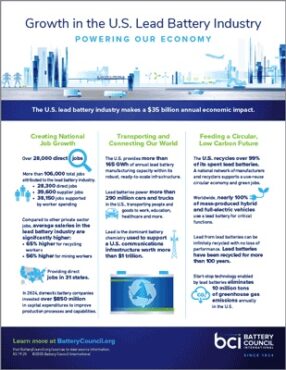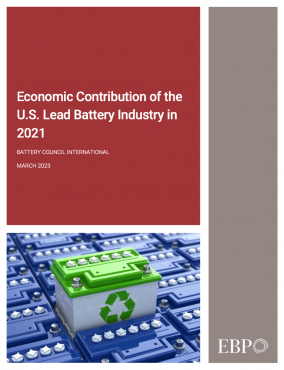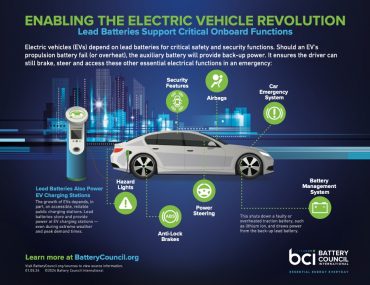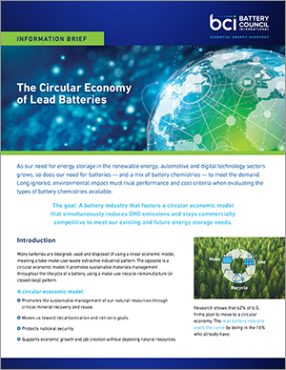
To coincide with National Battery Day, guest blogger and battery executive David Shaffer provides an overview of the exponential growth in the global battery market and what’s ahead. He is the president and CEO of EnerSys, and serves as president of the board of directors of Battery Council International.
This is an exciting time to be in the battery business. Over the next decade, the global battery market is estimated to grow 110%, which equates to $115 billion, according to a recent in-depth market report by Avicenne Energy, a private market research and consulting firm.

As we recognize National Battery Day on February 18th, I’d like to share some insights on factors driving this global growth and why a mix of existing and emerging battery technologies are needed to meet demand now and into the future.
Granted, this growth does not surprise those working at the forefront of the various battery market sectors, including material suppliers, manufacturers, distributors, recyclers, and R&D. The independent market analysis and forecasts by Avicenne – commissioned by the Consortium for Battery Innovation – predicted more than quadruple growth of batteries between 2015 and 2030, from 400,000 MWh to over 1,800,000 MWh.
Influential Factors
Some factors are outside of our control – for example, we saw slower growth in China due to the trade climate and, more recently, the coronavirus. However, I expect a return to normal as the trade environment improves and coronavirus concerns recede.
What is predictable are a number of well-documented macro trends that are influencing this tremendous growth. Foremost is that batteries are a key technology enabler for new concepts of mobility, connectivity and energy (e.g. telecommunications and data centers, electric mobility, stationary storage), which are all supported by the following:
- Population increase and city growth that challenge existing mobility and energy solutions; the increasing electrification of our planet
- A rapid increase in data consumption that strains existing services while awaiting the buildout of the 5G infrastructure
- A shift in energy production from fossil fuels and nuclear, with increasing focus on renewable energies as an alternative
- A growing global awareness of the impacts of global warming and the need to adopt green solutions, including circular economies that support sustainability
- The need for grid resiliency and security to protect big data from domestic and foreign data breaches
- The increased need for backup power to maintain connectivity (of all devices) between people and critical services, especially as natural disasters grow in frequency and severity
Lead Battery Market Growth
While each battery technology will have an essential role to play in different market applications, lead batteries and lithium-ion batteries are the two dominant battery types and the two chemistries with expected significant growth. At the close of 2018, lithium-ion batteries had the highest growth rate globally, while lead batteries owned the highest market share across the world at more than 70%. Furthermore, globally, the lead battery industry is expected to grow 50% from 2018 to 2030.
The lead battery industry growth will also generate positive economic impacts. A study released in 2019 reported these economic contributions for the U.S. lead battery industry:
- Nearly 25,000 direct jobs across 38 states
- Nearly 92,000 total jobs when factoring in suppliers and worker spending in different industries
- A contribution of $26.3 billion in total economic output to the national economy
Lead Battery Innovation and Sustainability
Other factors contributing to lead battery market growth include innovation and an extremely positive sustainability profile. Steady investment in lead battery research has increased the life of lead batteries by 30 to 35% in the last 20 years. The U.S. battery industry spent over $100 million on research and development in 2018.
In the U.S. and Europe, sustainability separates the lead battery industry from all other battery types. Groups like the World Economic Forum and The Sustainability Consortium recognize the industry as the model circular economy for other battery technologies and industries. In fact, nearly 99% of lead batteries are recycled (lithium-ion batteries are recycled at a rate below 5%), ensuring a steady domestic supply of raw materials for new lead batteries. U.S. lead battery manufacturers source approximately 70% of lead from domestic recycling facilities.
The reuse and remanufacture aspects of lead battery components further reduce reliance on importing materials from other countries, which trade or other unrest can disrupt.
Conclusion
As we celebrate National Battery Day, we honor the essentiality of all battery chemistries in our daily lives. We can’t predict the future, but we can ensure that investment in battery innovation continues, and not only in performance metrics. Those choosing battery systems must also consider a battery’s life cycle, namely, if that chemistry is responsibly sourced, used, reused and managed. That conversation is equally important to meeting global battery demand.
About David Shaffer
David M. Shaffer is the president and CEO of EnerSys, the global leader in batteries, chargers and accessories for motive, transportation, reserve, aerospace and defense applications worldwide. He also serves as president of the board of directors for Battery Council International. Shaffer holds an MBA from Marquette University and Bachelor of Science in mechanical engineering from the University of Illinois.
Sources:
Avicenne Report, Essential Energy Everyday, EnerSys








